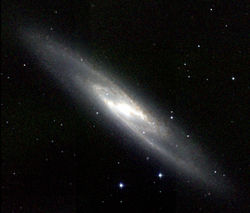Radial profile
The surface brightness radial profile of the galactic disc of a typical disc galaxy (viewed face-on) roughly follows an exponential function:

where  is the galaxy's central brightness and
is the galaxy's central brightness and  is the scale length. [2] The scale length is the radius at which the galaxy is a factor of e (≈2.7) less bright than it is at its center. Due to the diversity in the shapes and sizes of galaxies, not all galactic discs follow this simple exponential form in their brightness profiles. [3] [4] Some galaxies have been found to have discs with profiles that become truncated in the outermost regions. [5]
is the scale length. [2] The scale length is the radius at which the galaxy is a factor of e (≈2.7) less bright than it is at its center. Due to the diversity in the shapes and sizes of galaxies, not all galactic discs follow this simple exponential form in their brightness profiles. [3] [4] Some galaxies have been found to have discs with profiles that become truncated in the outermost regions. [5]
Vertical profile
When viewed edge-on, the vertical surface brightness profiles of galactic discs follow a very similar exponential profile that is proportional to the disc's radial profile:

where  is the scale height. Although exponential profiles serve as a useful first approximations, vertical surface brightness profiles can also be more complicated. For example, the scale height
is the scale height. Although exponential profiles serve as a useful first approximations, vertical surface brightness profiles can also be more complicated. For example, the scale height  , although assumed to be a constant above, can in some cases increase with the radius. [7]
, although assumed to be a constant above, can in some cases increase with the radius. [7]








